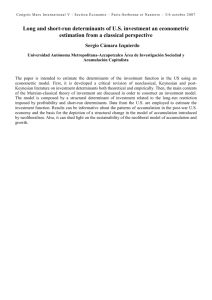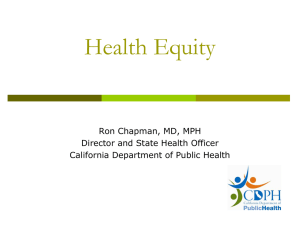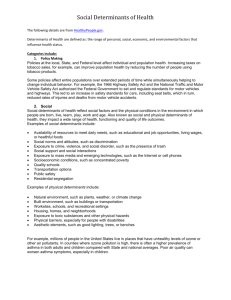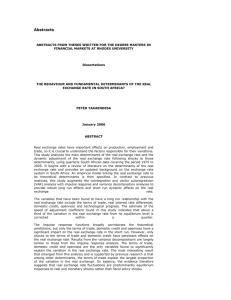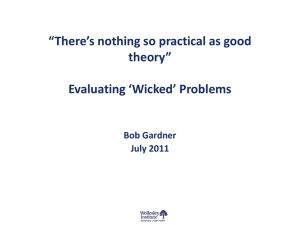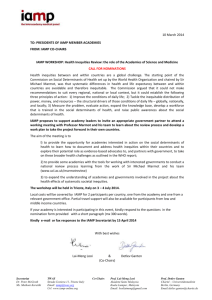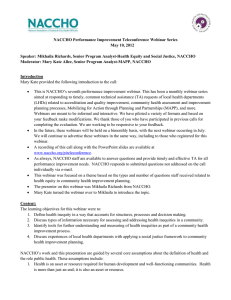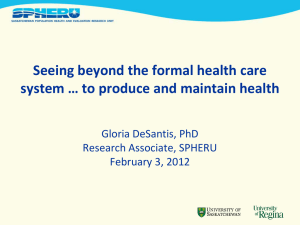How do these social determinants (and others)
advertisement
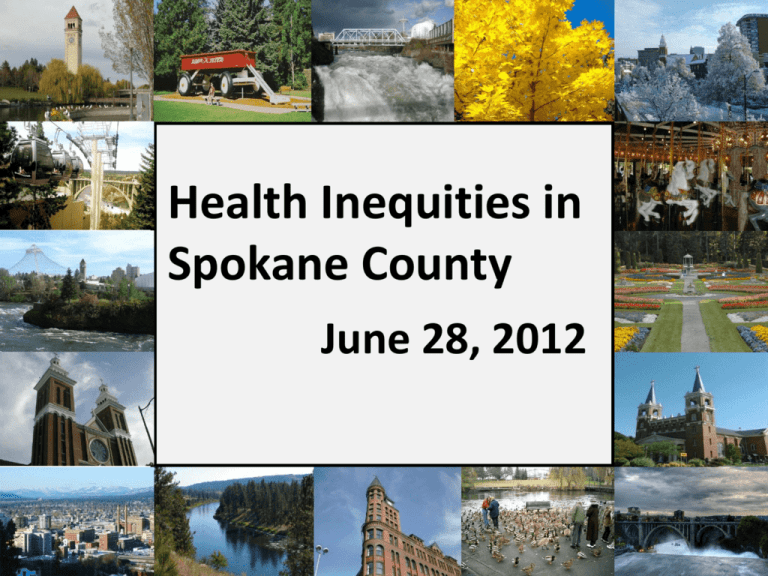
Health Inequities in Spokane County June 28, 2012 Questions • What does this information mean to you as a Board of Health member? • How can you use this information professionally? Personally? • How do these social determinants (and others) affect and impact members of your community? • Are some more relevant to your community than others? • What should/can we do as a Board of Health to address health inequities? A Framework Medical Model Genetics Individual Health Knowledge Socio-Ecological Upstream Downstream Institutional Power Social Inequities •Race •Class •Gender •Immigration status •National origin •Sexual orientation •Disability •Corporations & other businesses •Government agencies •Schools •Neighborhood conditions Social Physical •Residential segregation •Workplace conditions •Education Social Factors Risk Factors & Behaviors Disease & Injury Mortality •Smoking •Nutrition •Physical activity •Violence •Chronic stress •Infectious disease •Chronic disease •Injury (intentional / unintentional) •Infant mortality •Life expectancy Health Status Healthcare Access Discriminatory Beliefs (ISMS) Recap Important Points • Previous presentations analyzed data thru lens of 4 Social Determinants of Health • Inequitable distribution of health in Spokane County • Social gradient • Composite, not individual characteristics • Not only health, but also well being Components of Health Inequities Education Neighborhood Income/ Poverty Level Race/ Ethnicity Social Determinants of Health • • • • • • • • • • • Income and income distribution Early childhood development Employment and working conditions Food insecurity Housing Social Inclusion Social safety net Access to health services Gender Race and Ethnicity Disability Social Determinants of Health • Social determinants of health are the economic and social conditions under which people live which determine their health. • They are "societal risk conditions", rather than individual risk factors that either increase or decrease the risk for a disease. Whitehall Studies • Studies of British civil servants • Purpose: study mortality rates • Socioeconomic factors were not initially on the agenda • Finding: Inverse social gradient in mortality • Whitehall made it clear that inequalities in health were not limited to the health consequences of being poor! Whitehall I Study Income per head and life-expectancy: rich & poor countries Source: Wilkinson & Pickett, The Spirit Level (2009) www.equalitytrust.org.uk Health is related to income differences within rich societies but not to those between them Between (rich) societies Within societies age-adjusted mortality per 10,000 100 90 80 70 60 50 40 30 20 10 0 <10,000 12,000- 16,000- 20,000- 24,000- 28,000- 32,00013,999 17,999 21,999 25,999 29,999 33,999 Davey Smith et$US al.,1980 AJPH 1996 Source: Wilkinson & Pickett, The Spirit Level (2009) www.equalitytrust.org.uk Leading Causes of Death (Biomedical Model) Other 28% Diabetes mellitus 3% Unintentional injuries 4% Chronic respiratory disesaes 5% Cerebrovascular disease 7% Heart Disease 30% Malignant neoplasm 23% Source: Based on Mokdad, Marks, Stroup and Gerberding, JAMA, 291:10, 2004. Estimated actual causes of death in the US, 2004 Toxic agents Microbial agents 5% 7% Motor vehicle crashes 4% Alcohol 8% Tobacco 42% Diet/ physical inactivity 34% Source: Based on Mokdad, Marks, Stroup and Gerberding, JAMA, 291:10, 2004. McGinnis and Foege editorial • “it is also important to better capture and apply evidence about the centrality of social circumstances to health status and outcomes…the data are still not crisp enough to quantify the contributions [of social circumstances] in the same fashion as many other factors.” Estimated Deaths due to social conditions in the US, 2011 Income inequality 14% Individual level poverty 15% Area level poverty 4% Low education 28% (245,000) Low social support 19% (133,000) Source: Based on Galea, Tracy , Hoggart, DiMaggio and Karpati, AJPH, 11:8, August 2011. Racial segregation 20% (176,000) Leading Causes of Death by Model Biomedical model Preventable Causes of Death Social Causes Heart Disease-710,760 Tobacco-435,000 Low Education-245,000 Malignant neoplasm553,091 Poor Diet/Physical Inactivity- 400,000 Racial Segration-176,000 Cerebrovascular disease167,000 Alcohol consumption85,000 Low Social Support-133,000 Chronic lower respiratory disease-122,009 Microbial agents-75,000 Individual level poverty119,000 Determinants of Population Health Genes and Biology 9% Social / Societal Characteristics 53% Health Behaviors 20% Medical Care 18% Death rate per 100,000 person years Death Rate in the US by Median family income Source: Multiple Risk Factor Intervention Trial What SRHD is Doing About Health Inequities • Health inequity report - Odds Against Tomorrow • Creating awareness of health inequities in Spokane County – Presentations (40) with partners and community • Strategic Goal #4 – Education of SRHD staff • Organizing a community forum • Neighborhoods Matter • Health Promotion – Community Transformation Grant (CTG) Social Determinants of Health Conceptual Framework Socioeconomic & Political Context Social Position Governance Policy (Macroeconomic, Social, Health) Cultural and Societal Norms and Values Material Circumstances Education Social Cohesion Occupation Psychosocial Factors Income Behaviors Gender Biological Factors Race/Ethnicity Health Care System Structural Determinants of Health Inequity Intermediate Determinants of Health Inequity Distribution of Heath and Well-being Purpose of Odds Against Tomorrow Goals – • Increase awareness about different health and social factors in Spokane County • Provide information that could be used for potential changes affecting health outcomes • Identify further areas for exploration Audience – • • • • Health professionals Policy makers Community members Those interested in addressing health concerns in Spokane County Questions • What does this information mean to you as a Board of Health member? • How can you use this information professionally? Personally? • How do these social determinants (and others) affect and impact members of your community? • Are some more relevant to your community than others? • What should/can we do as a Board of Health to address health inequities?
